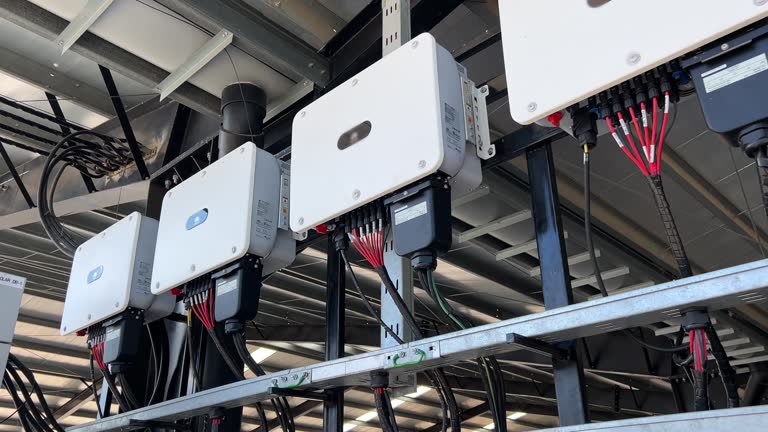Inverters are essential devices in various applications, from renewable energy systems to uninterruptible power supplies (UPS) and beyond. Their role in converting electrical power makes them pivotal to modern technology. This article delves into what inverters are, their types, working principles, and applications.
What is an Inverter?
An inverter is an electronic device that converts direct current (DC) into alternating current (AC). The power we get from the grid and most of the appliances run on AC, while solar panels, batteries, and other sources often provide DC. The inverter thus enables the seamless use of DC power in AC-powered devices, making it vital for systems like solar power setups and backup generators.
Inverters are used widely in many industries, including power electronics, automotive, telecommunications, and more. They serve to provide stable and reliable power for various needs, from household energy needs to industrial-scale solutions.
How Do Inverters Work?
Inverters convert DC power into AC by employing a process that involves several key steps. The most basic working principle includes the following steps:
1. DC Power Input
The inverter receives DC power from a source, such as solar panels, a battery, or a fuel cell. This DC input could vary in voltage, depending on the system’s requirements.
2. Conversion to AC
Once the inverter receives the DC power, it first steps up or steps down the voltage to the required level. The device uses a series of switches (such as transistors or thyristors) to create an oscillating signal, which mimics the AC waveform.
3. Filtering and Regulation
The oscillating signal, after going through the conversion process, is then passed through filters that smoothen out any fluctuations, ensuring the AC output is stable and clean. The filtered AC output is then sent to connected devices or the power grid.
4. Output Control
Most inverters allow for output control, meaning they can adjust the frequency and amplitude of the AC voltage to match the needs of different systems. This ensures compatibility with varying loads and application requirements.
Types of Inverters
There are several types of inverters, each suited for specific applications. The main types include:
1. Square Wave Inverters
Square wave inverters generate a simple square wave output. These inverters are the least expensive and efficient but also the least reliable. They work best with simple loads like electric heaters, which do not require precise AC waveforms. However, they may not be suitable for sensitive electronic devices, as they can cause disruptions and inefficiency.
2. Sine Wave Inverters
Sine wave inverters generate a pure sine wave output, which is the most efficient and stable form of AC power. These inverters are highly recommended for use with sensitive electronics, such as computers, televisions, and medical equipment. Pure sine wave inverters provide a cleaner power supply and have a minimal impact on devices that require consistent energy flow.
3. Modified Sine Wave Inverters
Modified sine wave inverters produce a waveform that is a modified version of a pure sine wave. These are more affordable than pure sine wave inverters but still offer decent efficiency. However, they can cause interference with some sensitive devices and may result in inefficient performance when used with motors and appliances that require precise power regulation.
4. Grid-Tie Inverters
Grid-tie inverters are used in solar power systems connected to the utility grid. They synchronize the power generated by solar panels with the grid’s AC voltage, feeding excess energy into the grid. These inverters usually operate at high efficiency and are designed to follow the grid’s voltage and frequency patterns.
5. Off-Grid Inverters
Off-grid inverters, also known as stand-alone inverters, are used in systems that operate independently of the grid. These inverters provide power from off-grid sources, such as solar panels, batteries, or wind turbines, and supply AC power to homes or businesses. They are commonly used in remote locations where grid connection is unavailable.
Applications of Inverters
Inverters have a wide array of applications across different sectors. Some of the prominent uses include:
1. Renewable Energy Systems
One of the most popular uses of inverters is in solar power systems. Solar panels produce DC electricity, and inverters are used to convert this DC power into AC so it can be used in homes and businesses. Inverters also allow for the excess power generated to be sent back to the grid in grid-tied systems.
Similarly, wind turbines also generate DC power, which requires an inverter to convert it into usable AC power.
2. Uninterruptible Power Supplies (UPS)
Inverters are a crucial component in UPS systems. These devices provide backup power during electrical outages by converting the stored DC power (usually from batteries) into AC power. This ensures that critical devices, such as computers, medical equipment, and industrial machinery, continue to function during power failures.
3. Electric Vehicles
Electric vehicles (EVs) rely on inverters to convert DC power from the battery into AC power, which is used to drive the electric motor. Inverters in EVs also help regulate motor speed and torque, ensuring optimal performance.
4. Industrial Applications
Inverters are used in industrial applications to control the speed of motors, such as in conveyor systems, pumps, and fans. By adjusting the frequency of the AC power supplied to these motors, inverters can optimize energy efficiency and improve performance.
5. Home Appliances
Many modern home appliances, such as refrigerators, air conditioners, and washing machines, use inverters to improve energy efficiency. Inverters help adjust the speed of the motors in these appliances, reducing energy consumption and wear and tear.
Conclusion
Inverters play a vital role in the conversion of DC to AC power, making them indispensable in modern energy systems, renewable energy applications, and a variety of industries. Whether in solar power systems, backup power supplies, or electric vehicles, inverters ensure that power is used efficiently and reliably. With advancements in inverter technology, we can expect even greater efficiency, sustainability, and versatility in the coming years.
